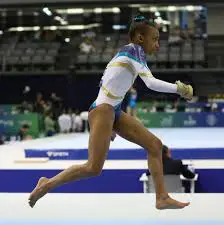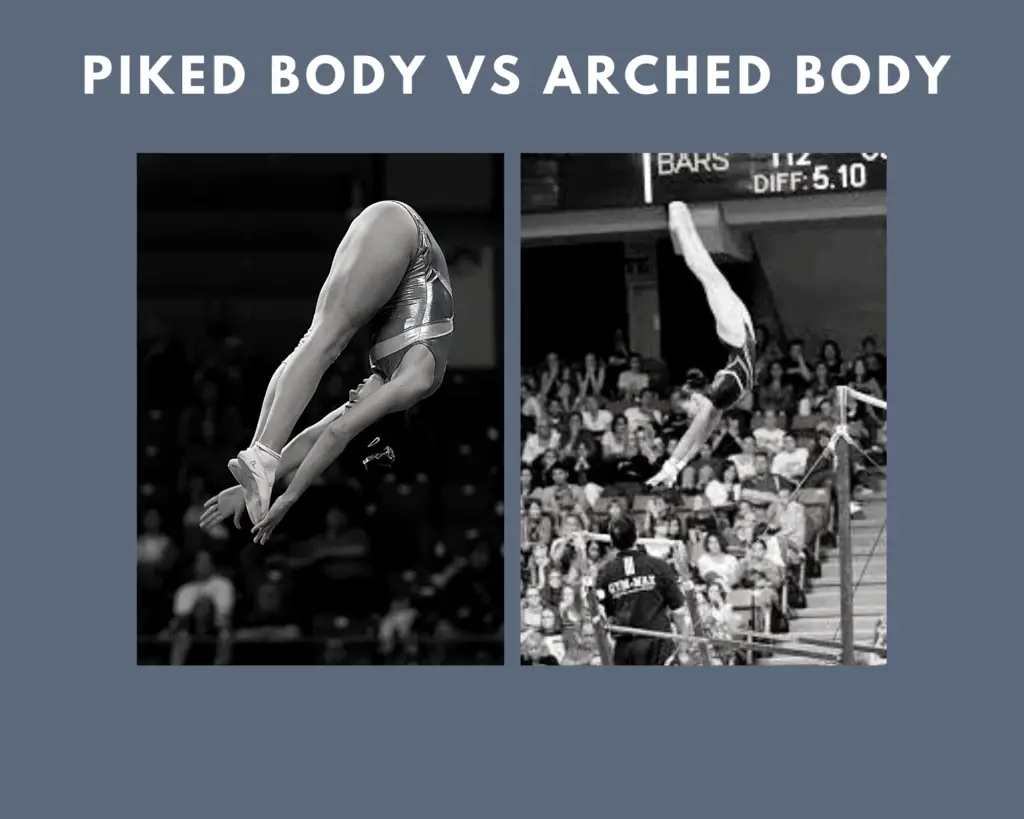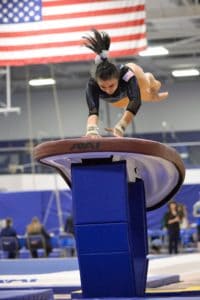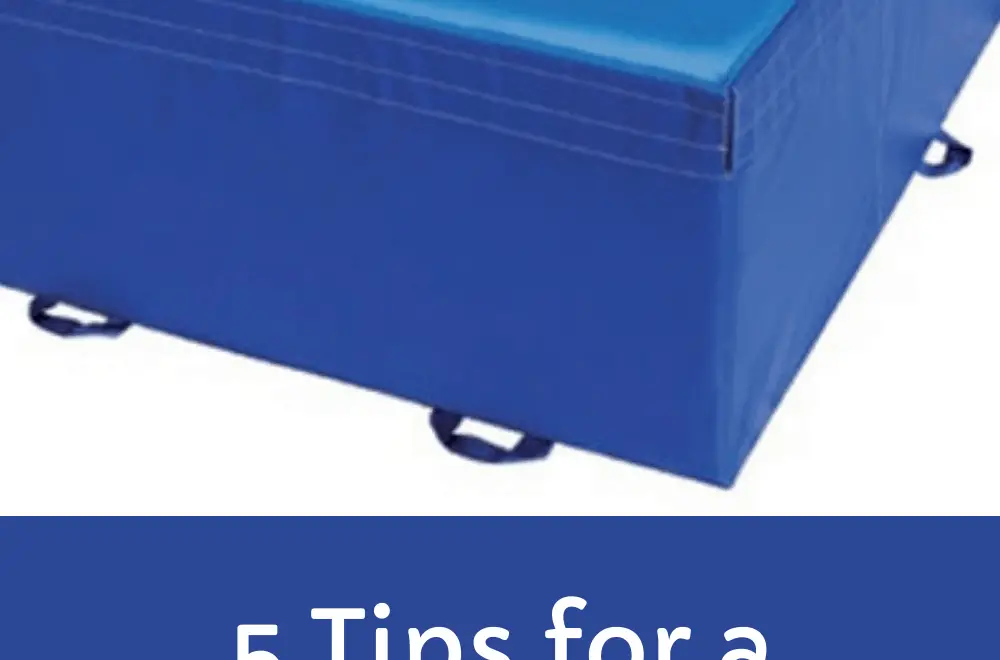The Level 2 vault – what in the world is it? When the flat back vault was first introduced, it had already been used by coaches in training for a long time. But no one knew how it would be scored in a meet. Judges complained that it was difficult to judge. Coaches complained that they didn’t know what the judges were looking for. As coaches, we were used to using this “vault” as a drill. But competing it? It’s so different than a regular vault that goes over the table!
Luckily, things are much better today. Scores are generally consistent across the board when judging this vault. We’re all used to it as part of a compulsory meet. But I often get asked, what are the biggest deductions on this vault? How can we score better? Today, we’ll talk about 5 ways to improve your score on Level 2 vault.
At Level 2, the mat stack must be at least 16” high. There is no deduction for adding more mats to make the stack higher.
What is the Level 2 vault?
The Level 2 vault is a jump to handstand, fall to flat back on a mat stack or resi pit. The goal of the Level 2 vault is to train the gymnast in the vaulting approach (link) and body position necessary for the Level 3, 4 and 5 handspring vault. To perform this vault correctly, the gymnast should display a strong run and straight body position throughout the vault.
Here’s a video of the Level 2 vault:
Why do these gymnasts vault onto a mat stack?
Prior to the flat back vault, gymnasts used to have the option to perform either a squat through or a handspring vault. The squat through vault just wasn’t progressive, and gymnasts struggled to perform the handspring when they first started to compete it. The introduction of the vault table in 2001 made it even more challenging for the smallest gymnasts to perform the handspring. As a result, the folks at USA Gymnastics realized that a lead-up to a handspring would be beneficial for these beginning compulsory athletes, and they adopted the flat back vault.
Not only is the flat back vault a good lead-up for the handspring, but it’s also much less intimidating for gymnasts learning to vault. Running full speed at a large, immovable object is scary! The mat stack, or resi pit, is soft, and provides a cushioned surface for these gymnasts to learn. They can practice their technique without the fear of running into the vault table.
What are the points of emphasis for a Level 2 vault?
There are five main areas to focus on when training a Level 2 vault. Not only will focusing on these areas improve your Level 2 vault scores, but they will also prepare the gymnast to perform a great handspring vault once she reaches Level 3 and above!
The Run and Approach

Every great vault starts with a strong run and board contact. Level 2 is only level in which the run and approach are evaluated. There are three different categories which are evaluated during the run. They are: acceleration, horizontal running speed, and body position on the board. The deduction is up to 0.30 in each category.
First, the judges evaluate the gymnast’s acceleration during the run. The gymnast should continually increase her running speed as she moves down the runway. If she is not running at her maximum speed before she contacts the board, a deduction can be taken.
Next, she must maintain that running speed as she approaches the board. Many gymnasts will accelerate, but then slow down in preparation for the hurdle and board contact. If the gymnast slows down, she will receive this deduction. Other errors that can lead to a deduction are long, leaping steps into the hurdle, or stutter steps as the gymnast approaches the board.
Finally, the gymnast should hit the board in an upright position, with her feet in front of her body. Deductions can be applied for an excessive forward lean. Many gymnasts lean forward on the board as they are reaching toward the mat stack. Not only will these gymnasts receive a deduction for body position on the board, but often they will pike their bodies in the pre-flight, leading to additional deductions.
See more: The Essential Guide to a Great Vault Run
Body Position
Body position errors account for many of the largest deductions in the Level 2 vault. Part of the reason for this is that body position deductions can be taken in each of the three phases: preflight, support phase, and postflight. In case you haven’t heard those terms, preflight is the part of the vault in between the springboard and the table, support phase is the time when the gymnast’s hands are on the table, and postflight is the time between leaving the table and landing on the mat.
The ideal body position during a flat back vault is a straight line from the hands to the feet. The head should be neutral. During the preflight, the arms may not have fully extended overhead, but by the time the gymnast reaches the support phase, the arms should be overhead. More on that later.

If the gymnast shows a different body position that is not stretched, there is a deduction. A piked body will get a deduction of up to 0.50, and an arched body will get a deduction of up to 0.30. These deductions are taken in each phase of the vault. Other deductions taken in each phase include bent legs (up to 0.30 each), legs separated (up to 0.20 each), foot form (up to 0.10 each), and head alignment (up to 0.10 each). Since each deduction could be multiplied by three, those form deductions can add up quickly!
Arm, Head, and Shoulder Position

Next, we’ll talk about errors in arm, head, and shoulder position. The gymnast should perform the vault with arms straight (up to 0.50) and head neutral (up to 0.10). If she completely bends her arms so that the head contacts the mat, the deduction increases to 2.00! The correct shoulder alignment is defined as a shoulder angle of 180°. In other words, the shoulders should be completely extended in the support phase, or there is a deduction of up to 0.30. Another large deduction is a 0.50 penalty for placing the hands beyond the tape line on the mat. If only one hand lands beyond the line, it is a 0.20 deduction.
These arm and shoulder angle deductions only apply in the support phase, so they may not be as costly as the body position deductions. However, these qualities make a big difference in the way the vault is performed! If the gymnast has bent arms or a shoulder angle, she will be unable to get a good push off the table once she learns her handspring. Paying attention to these details in Level 3 will pay off in the long run as the gymnast learns more difficult vaults.
The Vertical Handstand
A big part of the handstand flat back vault is – you guessed it – the handstand! There are two very large deductions if a gymnast does not show a vertical handstand on the mat. The first deduction is for failure to show an inverted vertical position from the hands to the hips, and it is worth up to 2.00. This deduction is applied if the gymnast performs a forward roll instead of a straight body fall to flat back position. If the gymnast performs a dive roll and never attempts the handstand position, she will likely receive a deduction close to the full 2.00. If she hits the handstand, but rolls down, she will still receive a sizeable deduction, but it would likely be in the 0.50-1.00 range depending on the severity of the roll.
The other large deduction is for contacting the mat with the hands when the body is already past vertical. This deduction is up to 1.00 (0-45° past vertical is up to 0.50, 45°-90° is 0.55-1.00). The gymnast should touch the mat stack with her hands well before her body reaches vertical. The reason for this is that when she learns a handspring over the table, she won’t be able to get much height and power if her hands don’t leave the table near vertical. So in Level 2, the goal is to get the hands to the mat stack early. This teaches the gymnast the correct technique for the handspring vault.
Dynamics
The final deduction I will discuss today is dynamics. Dynamics refers to the overall power and speed of the vault. A gymnast with good dynamics makes the difficult skills look easy.
Of all these categories, dynamics is the smallest deduction, at only up to 0.30. The reason I have included it here is because good dynamics gives the judges a good overall impression of the vault. It’s easier to see body position errors in a vault that moves slowly. The judges might also consider more run deductions if the vault is not as quick.
Finally, good dynamics is important, just as all of these categories are, when it comes to vault progressions. A gymnast who performs her Level 2 vault with great body position, but doesn’t get any repulsion off the mat, is not as likely to perform well at Level 3 and above. There is NO deduction for lack of repulsion, but it’s a good idea to begin to teach repulsion at Level 2, in preparation for the Level 3 handspring.
Final Thoughts
A great Level 2 vault will excel in 5 areas: the run, body position, arm and shoulder position, a vertical handstand, and dynamics. Coaches and gymnasts who focus on these areas will not only score well at Level 3, but they will have a leg up when they get to the Level 4 handspring vault! Coaches, what are your favorite drills for each of the parts of this vault?
Further Reading
The Essential Guide to a Great Vault Run
5 Tips for a Stellar Handspring Vault
Tips and Resources to Boost Your Level 6/7 Vault Score
Xcel Vault: What You Should Know
How to Perfect Your Level 3 Bar Routine
How to Perform the Best Level 3 Beam Routine
References
USA Gymnastics J.O. Compulsory Handbook, 2013-2021.
